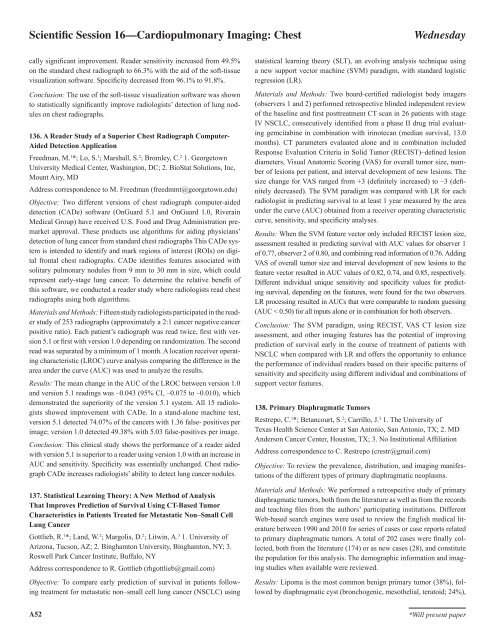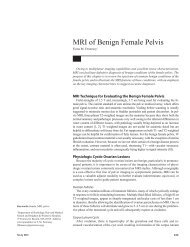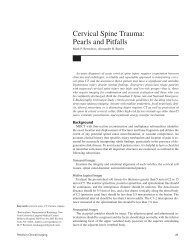Scientific Session 1 â Breast Imaging: Mammography
Scientific Session 1 â Breast Imaging: Mammography
Scientific Session 1 â Breast Imaging: Mammography
You also want an ePaper? Increase the reach of your titles
YUMPU automatically turns print PDFs into web optimized ePapers that Google loves.
<strong>Scientific</strong> <strong>Session</strong> 16—Cardiopulmonary <strong>Imaging</strong>: ChestWednesdaycally significant improvement. Reader sensitivity increased from 49.5%on the standard chest radiograph to 66.3% with the aid of the soft-tissuevisualization software. Specificity decreased from 96.1% to 91.8%.Conclusion: The use of the soft-tissue visualization software was shownto statistically significantly improve radiologists’ detection of lung noduleson chest radiographs.136. A Reader Study of a Superior Chest Radiograph Computer-Aided Detection ApplicationFreedman, M. 1 *; Lo, S. 1 ; Marshall, S. 2 ; Bromley, C. 2 1. GeorgetownUniversity Medical Center, Washington, DC; 2. BioStat Solutions, Inc,Mount Airy, MDAddress correspondence to M. Freedman (freedmmt@georgetown.edu)Objective: Two different versions of chest radiograph computer-aideddetection (CADe) software (OnGuard 5.1 and OnGuard 1.0, RiverainMedical Group) have received U.S. Food and Drug Administration premarketapproval. These products use algorithms for aiding physicians’detection of lung cancer from standard chest radiographs This CADe systemis intended to identify and mark regions of interest (ROIs) on digitalfrontal chest radiographs. CADe identifies features associated withsolitary pulmonary nodules from 9 mm to 30 mm in size, which couldrepresent early-stage lung cancer. To determine the relative benefit ofthis software, we conducted a reader study where radiologists read chestradiographs using both algorithms.Materials and Methods: Fifteen study radiologists participated in the readerstudy of 253 radiographs (approximately a 2:1 cancer negative:cancerpositive ratio). Each patient’s radiograph was read twice, first with version5.1 or first with version 1.0 depending on randomization. The secondread was separated by a minimum of 1 month. A location receiver operatingcharacteristic (LROC) curve analysis comparing the difference in thearea under the curve (AUC) was used to analyze the results.Results: The mean change in the AUC of the LROC between version 1.0and version 5.1 readings was –0.043 (95% CI, –0.075 to –0.010), whichdemonstrated the superiority of the version 5.1 system. All 15 radiologistsshowed improvement with CADe. In a stand-alone machine test,version 5.1 detected 74.07% of the cancers with 1.36 false- positives perimage; version 1.0 detected 49.38% with 5.03 false-positives per image.Conclusion: This clinical study shows the performance of a reader aidedwith version 5.1 is superior to a reader using version 1.0 with an increase inAUC and sensitivity. Specificity was essentially unchanged. Chest radiographCADe increases radiologists’ ability to detect lung cancer nodules.137. Statistical Learning Theory: A New Method of AnalysisThat Improves Prediction of Survival Using CT-Based TumorCharacteristics in Patients Treated for Metastatic Non–Small CellLung CancerGottlieb, R. 1 *; Land, W. 2 ; Margolis, D. 2 ; Litwin, A. 3 1. University ofArizona, Tucson, AZ; 2. Binghamton University, Binghamton, NY; 3.Roswell Park Cancer Institute, Buffalo, NYAddress correspondence to R. Gottlieb (rhgottlieb@gmail.com)Objective: To compare early prediction of survival in patients followingtreatment for metastatic non–small cell lung cancer (NSCLC) usingstatistical learning theory (SLT), an evolving analysis technique usinga new support vector machine (SVM) paradigm, with standard logisticregression (LR).Materials and Methods: Two board-certified radiologist body imagers(observers 1 and 2) performed retrospective blinded independent reviewof the baseline and first posttreatment CT scan in 26 patients with stageIV NSCLC, consecutively identified from a phase II drug trial evaluatinggemcitabine in combination with irinotecan (median survival, 13.0months). CT parameters evaluated alone and in combination includedResponse Evaluation Criteria in Solid Tumor (RECIST)–defined lesiondiameters, Visual Anatomic Scoring (VAS) for overall tumor size, numberof lesions per patient, and interval development of new lesions. Thesize change for VAS ranged from +3 (definitely increased) to –3 (definitelydecreased). The SVM paradigm was compared with LR for eachradiologist in predicting survival to at least 1 year measured by the areaunder the curve (AUC) obtained from a receiver operating characteristiccurve, sensitivity, and specificity analyses.Results: When the SVM feature vector only included RECIST lesion size,assessment resulted in predicting survival with AUC values for observer 1of 0.77, observer 2 of 0.80, and combining read information of 0.76. AddingVAS of overall tumor size and interval development of new lesions to thefeature vector resulted in AUC values of 0.82, 0.74, and 0.85, respectively.Different individual unique sensitivity and specificity values for predictingsurvival, depending on the features, were found for the two observers.LR processing resulted in AUCs that were comparable to random guessing(AUC < 0.50) for all inputs alone or in combination for both observers.Conclusion: The SVM paradigm, using RECIST, VAS CT lesion sizeassessment, and other imaging features has the potential of improvingprediction of survival early in the course of treatment of patients withNSCLC when compared with LR and offers the opportunity to enhancethe performance of individual readers based on their specific patterns ofsensitivity and specificity using different individual and combinations ofsupport vector features.138. Primary Diaphragmatic TumorsRestrepo, C. 1 *; Betancourt, S. 2 ; Carrillo, J. 3 1. The University ofTexas Health Science Center at San Antonio, San Antonio, TX; 2. MDAnderson Cancer Center, Houston, TX; 3. No Institutional AffiliationAddress correspondence to C. Restrepo (crestr@gmail.com)Objective: To review the prevalence, distribution, and imaging manifestationsof the different types of primary diaphragmatic neoplasms.Materials and Methods: We performed a retrospective study of primarydiaphragmatic tumors, both from the literature as well as from the recordsand teaching files from the authors’ participating institutions. DifferentWeb-based search engines were used to review the English medical literaturebetween 1990 and 2010 for series of cases or case reports relatedto primary diaphragmatic tumors. A total of 202 cases were finally collected,both from the literature (174) or as new cases (28), and constitutethe population for this analysis. The demographic information and imagingstudies when available were reviewed.Results: Lipoma is the most common benign primary tumor (38%), followedby diaphragmatic cyst (bronchogenic, mesothelial, teratoid; 24%),A52*Will present paper
















